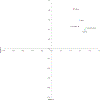Clinical outcomes of low vision rehabilitation delivered by a mobile clinic
- PMID: 29485207
- PMCID: PMC6448563
- DOI: 10.1111/opo.12440
Clinical outcomes of low vision rehabilitation delivered by a mobile clinic
Abstract
Purpose: This prospective cohort study examined clinical outcomes of low vision rehabilitation (LVR) delivered by a mobile clinic.
Methods: Participants were recruited from those scheduled for mobile clinic LVR and met the United States definition of legal blindness. Participants completed the Massof Activity Inventory (AI) before LVR, 3 months post-LVR, and 1 year post-LVR. Change scores and measures of clinical effect (i.e. Cohen's effect size and minimum clinically important difference, MCID) were calculated for each time point and compared. Additional participant characteristics (age, acuity, contrast sensitivity, cause of visual impairment, training recommendations, and prior LVR experience) were also explored with respect to outcome measures.
Results: Of the 66 participants enroled in this study, 47% had no prior LVR experience. Significant differences were noted between baseline and 3-month person measures, and between baseline and 1-year person measures. There was no significant difference between 3-month and 1-year person measures, nor was there a significant difference in change score between these two time points. At 1 year post-LVR, overall visual ability effect size was 0.74. A clinically meaningful outcome was achieved in 56% of participants at 3 months and 71% at 1 year for overall visual ability. There was no significant difference in the proportion of participants achieving MCID at 3 months vs 1 year. Of participants who completed the 1-year post-LVR AI, 59% reported a subjective worsening of vision during the study period. This subgroup also tended to have smaller 1-year change scores.
Conclusions: Mobile clinic LVR is effective at expanding access to care and produces clinically meaningful outcomes comparable to those seen in other outpatient LVR delivery models.
Keywords: epidemiology; low vision.
© 2018 The Authors Ophthalmic & Physiological Optics © 2018 The College of Optometrists.
Figures






References
-
- Massof RW. A model of the prevalence and incidence of low vision and blindness among adults in the U.S. Optom Vis Sci 2002; 79: 31–38. - PubMed
-
- Stelmack JA, Szlyk JP, Stelmack TR et al. Measuring outcomes of vision rehabilitation with the Veterans Affairs Low Vision Visual Functioning Questionnaire. Invest Ophthalmol Vis Sci 2006; 47: 3253–3261. - PubMed
-
- Stelmack JA, Tang X & Reda D. Outcomes of the verterans affairs low vision intervention trial (LOVIT). Arch Ophthalmol 2008; 126: 608–617. - PubMed
-
- Stelmack JA, Tang X, Wei Y et al. Outcomes of the veterans affairs low vision intervention trial II (LOVIT II): a randomized clinical trial. JAMA Ophthalmol 2017; 135: 96–104. - PubMed
Publication types
MeSH terms
Grants and funding
LinkOut - more resources
Full Text Sources
Other Literature Sources
Miscellaneous

